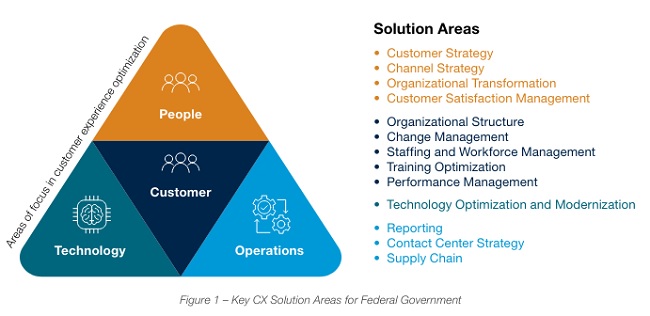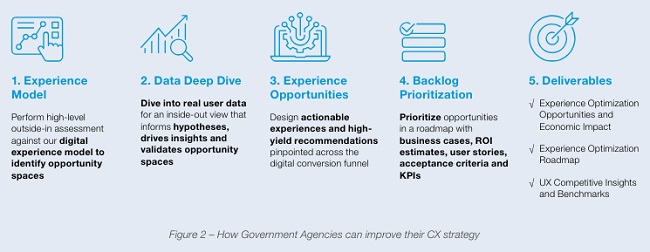The government's focus on CX is a strategic investment aimed at improving services and fostering trust. It recognizes that citizens should be treated as valued customers.
In today's digital age, the federal government has made customer experience (CX) an essential element of public service delivery. CX comprises the entire customer journey from customer acquisition to provisioning and retention. This includes creating a 360-degree view of the customer across multiple channels and platforms, with knowledge management, predictive and real-time insights, and a feedback loop to enhance CX. The government's focus on CX (and associated technologies) is a strategic investment. It reflects a broader shift toward citizen-centric governance, aimed at improving services, fostering trust and creating a cohesive strategy that uses best practices to integrate digital design, technology and customer support functions. The current administration has built upon previous progress by adopting CX practices The government's focus on CX is a strategic investment aimed at improving services and fostering trust. It recognizes that citizens should be treated as valued customers. and making a strong commitment to creating a more responsive, accountable, and citizen-centric government by encouraging agencies to listen to and address the needs and expectations of the American people. Federal agencies understand the importance of CX and are actively transforming their approaches, particularly to reach historically underserved individuals and communities. This shift in focus is not merely cosmetic; it represents a fundamental change in the way agencies operate, placing the citizens at the center.
The shift to focusing on CX— placing citizens at the center— represents a fundamental change in the way federal agencies operate.
The significance of CX in government operations has grown significantly, driven by the recognition that citizens should be treated as valued customers, not just recipients of services. In an era where people expect seamless, user-friendly digital experiences, these same expectations extend to interactions with government agencies, ensuring inclusivity and accessibility for everyone. Strong technology enablement is critical for creating customer experiences that drive value for the government. IT leaders need to take a proactive approach to developing a strong portfolio of customer interaction applications that are in lockstep with the needs of their users, incorporating the voice of the customer into this strategy. When developing a digital CX strategy, government agencies have been trying to move the needle forward by providing capabilities for customer intelligence, omnichannel interactions and predictive analytics while rationalizing spending on key contracts and initiatives to achieve the expected CX goals and outcomes.
Strong technology enablement incorporating the voice of the customer is critical for creating customer experiences that drive value for the government
Driving Change in Government Through CX
Taking the lead from the President's Management Agenda, most agencies have made CX a key part of their strategic plans and have begun to integrate these plans into their operations. One of the driving forces behind this is Executive Order 14058 on Improving the Federal Customer Experience, issued by President Biden in late 2021.
Executive Order 14058 (E.O.) directs federal agencies to take comprehensive steps to improve customer experiences and service delivery. Agencies must use human-centered design principles, infuse CX practices into internal processes, establish customer feedback mechanisms and use datadriven decision-making to eliminate inefficiencies, increase accessibility for hard-to-reach communities and enhance the overall customer experience.
Executive Order 14058 directs federal agencies to take comprehensive steps to improve CX and service delivery, approached through the life events of citizens.
The Executive Branch has also designated 17 federal agencies as High Impact Service Providers (HISP), including the Departments of Education, Veterans Affairs and the Social Security Administration. These HISPs provide the most highimpact customer services and must aim to modernize programs, reduce administrative burdens and pilot new online tools and technologies.
17 federal agencies designated as High Impact Service Providers, including Depts. of Ed., VA and SSA, must modernize programs, reduce administrative burdens and pilot new online tools and technologies.
Importantly, the government is on the cusp of a more subtle structural change as a result of this E.O. By categorizing its approach based on life events experienced by Americans rather than agency statutory boundaries, this E.O. places citizens at the center and encourages agencies to collaborate, share data and design new tools and technologies from the customer's perspective, not their own. This is one of the most significant shifts in decades in how the federal government works to meet the needs of Americans.
Key Components of the Current Federal CX Initiative
The federal CX initiative includes several key themes designed to create a citizen-centric government:
- 1. Soliciting and Utilizing Customer Feedback: Agencies are encouraged to actively seek and use feedback from citizens to identify areas for improvement. The goal is to listen to the voices of those interacting with government services and tailor offerings accordingly.
- 2. Embracing Data-Driven Decision-Making: The CX initiative places a strong focus on data analytics to understand how citizens engage with government services. By leveraging data, agencies can make informed decisions and optimize service delivery.
- 3. Creating Service Standards and Metrics: Setting specific service standards, Key Performance Indicators (KPI's) and metrics ensure accountability. Federal agencies must establish clear expectations for service delivery and communicate those expectations openly, making it easier for citizens to gauge the quality of services.
- 4. Encouraging Collaboration and Sharing Best Practices: The federal administration encourages collaboration among agencies to share best practices of successful CX strategies, and the current CX effort is no exception. This cooperative approach should accelerate the adoption of a holistic, government-wide effort to prioritize CX.
An Example of Progress on Federal CX
As one of the designated HISPs, the Department of Veterans Affairs (VA) has already taken steps towards adopting and applying the best practices of customer experience (CX) from government and industry to the delivery of quality care, benefits and services for Veterans and their families by creating the Veterans Experience Office (VEO). The VEO applies best practices of data, tools, technology, and engagement to provide CX insights and services and embed the "voice of the Veteran" into all policy, planning, programs, and practices to improve the Veteran experience. The VEO continues to be instrumental in streamlining services and implementing tailored programs by engaging Veterans directly in the decisionmaking process to earn their trust, and give them every reason to choose the VA.
With CX data grounded in human-centered design, customer journey maps and real-time customer feedback via a digital survey platform, the VEO is prioritizing the end-user to build and deliver tools and products that increase targeted, accessible services. These efforts, along with the use of technology solutions and engagement strategies, will create a more unified customer experience for the Veterans.
Alvarez & Marsal's Approach to CX in Government
At A&M, we focus on fast-acting, results-driven implementation to support our clients. This approach, along with the capabilities of our Federal and A&MPLIFY practice, shapes how A&M tackles the challenges of incorporating CX into public service delivery. We believe it is critical to engage with end-users to understand their needs for digital CX.
A&M Federal assists both civilian and defense agencies with transformation to improve readiness and operations, and to optimize the capability of organizational assets. Our professionals have extensive experience in strategic planning, organizational redesign and technology modernization. The solutions we provide to federal agencies are influenced by our understanding of the importance of a people-centric approach and the nuances of working with and for the government.

A&MPLIFY, which leads A&M's CX and Digital Transformation unit, combines the power of experience design, artificial intelligence, and technology to create digital solutions for clients across industries. The team utilizes a data-driven approach to establish tailored accelerators and programs to help organizations achieve sustainable value at speed and scale. One of A&MPLIFY's key CX offerings, experience optimization, helps organizations to identify pain points and create actionable solutions to improve the digital experience.
A&MPLIFY Experience Optimization Process

At a high level, our CX offering helps organizations embrace digital CX by:
- Mapping customer journeys, needs and pain points for key departments
- Defining customer value proposition, competitive differentiation and competitive positioning
- Developing strategies and investment plans for modern data platforms
- Establishing formal CX metrics and reporting tools
- Creating CX functions and centralized capabilities within organizations
- Developing strategies to organize customer operations in line with customer journey
- Establishing CX standards across governance touchpoints within organizations and personnel
- Implementing experience-oriented delivery models with cross-functional teams to improve overall processes
- Gathering data to validate value and shape future digital roadmaps
- Creating innovation blueprints for organization wide operations
Together, the Federal and A&MPLIFY practice is helping the government with solutions to improve technology so that it can be leveraged to streamline both public-facing and internal processes using service design and the delivery of digital products. The close integration of capabilities is needed to innovate, automate and create the superior digital customer experience that the federal government desires.
Looking Ahead
New executive leaders are expected to "hit the ground running." In doing so, they often will make assumptions about the agency, its customer and the business need. Innovation-led organizations are quickly adopting agile approaches to managing their business based on hypotheses built from end-user feedback to drive results. Agile is based on the idea in which informed hypotheses are created, user input is captured, ideas are prototyped and tested, and solutions are evolved based on key outcomes and impact.
A&M's approach to CX is Agile, creating informed hypotheses, capturing user input, prototyping and testing ideas, and producing solutions based on key outcomes and impact.
As the government looks to continuously ramp up the digital CX experience, it will require experts who can innovate, incorporate integrated technologies, and prioritize agile implementation. While progress has been made toward integrating CX into the federal government's service delivery, support from the private sector is essential to making enhanced CX a reality across agencies and citizen experiences.
Originally Published 13 February 2024
The content of this article is intended to provide a general guide to the subject matter. Specialist advice should be sought about your specific circumstances.




